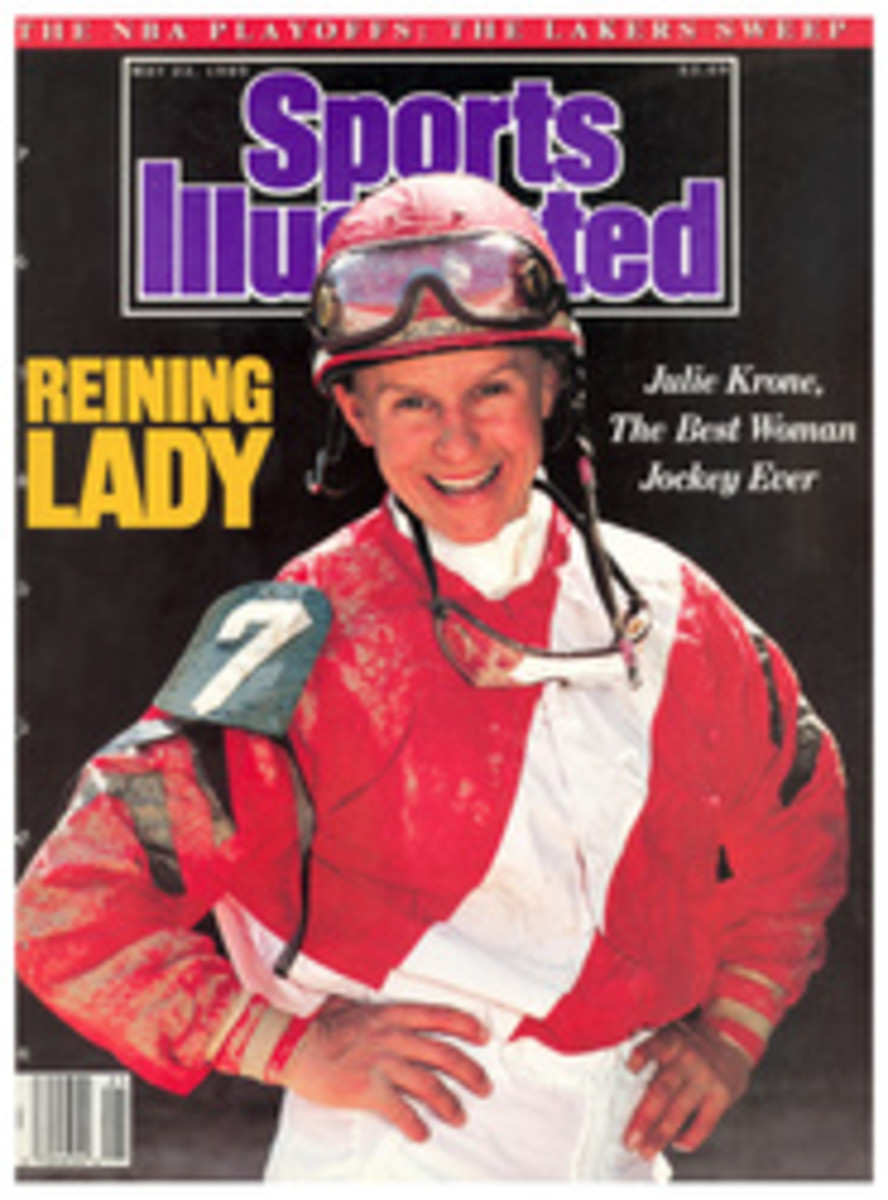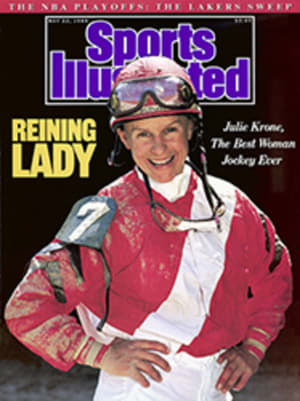
THE BASES ARE LOADED WITH NEW TITLES
The annual spring deluge of baseball books is upon us and this year, in at least one sense, may represent a high-water mark. The sheer volume of titles is overwhelming. Here's a guide through the flood, which includes books to curl up with during a rain delay and one to leave on the bench.
Starting with the statistical side of the game: The 2,875-page Baseball Encyclopedia (Macmillan, $45), the most widely used argument settler, has a rookie challenger, Total Baseball (Warner Books, $49.95). Its 2,294 pages have been divided into two parts, part one consisting of essays on such subjects as the origin of the sport, "Baseball Nicknames," "Black Ball" and "Women in Baseball." Part two is an alphabetized register and statistical record.
Total Baseball reflects the increasingly sophisticated ways in which followers of the game are using statistics. Augmenting the usual batting and pitching categories are such new ones as the "Clutch Hitting Index," developed by the Society for American Baseball Research (SABR); "Runs Created" is a Bill James creation; and "Total Average," a formula devised by Thomas Boswell of The Washington Post. Baseball traditionalists may blanch when they see revered entries like Ted Williams's .406 batting average surrounded by numbers that are meaningless to all but stats filberts. Moreover, Total Baseball sometimes lapses into a self-righteous, pedantic tone: "Let's start with...that venerable, uncannily durable fraud, the batting average. (It consists simply of hits divided by at-bats.)"
Hey, I kind of like baseball's simplicity. Part of the fun of playing with stats is understanding them without using the sine function of a calculator. Still, the scope of Total Baseball will make it the baseball reference work for years to come. What's more, it's just as good as The Baseball Encyclopedia for settling arguments—a blow over the head with either tome will instantly stop any disagreement.
Though the small type makes the entries in The Sports Encyclopedia: Baseball (St. Martin's, $16.95) as difficult to find as Eddie Gaedel's strike zone, this paperback, with stats organized team by team for each year, is a reasonably priced phone-book-sized paperback alternative to the two hardcovers.
That this is a particularly rich year for stat books comes as little surprise. Even the most obtuse publisher could see that the explosion of Rotisserie Leagues around the country has created a huge demand for books that present column upon column of comparable digits. Two of the game's originators have produced a 1989 edition of Rotisserie League Baseball (Bantam Books, $7.95). Edited by Glen Waggoner and Robert Sklar, Rotisserie includes, along with pertinent stats and impertinent wisecracks, additions to the league's constitution and an introduction to an advanced form of the game called Rotisserie Ultra.
Two other books for Rotisserie players are The Fantasy Baseball Abstract 1989 (Perigee, $8.95), by Wayne M. Welch, and Patton's 1989 Fantasy Baseball Price Guide (Fireside, $8.95), by Alex Patton. Both rank players by position according to the stats that are most important to Rotisserie devotees, and both are reliable resources for drafting a team or justifying a trade. Patton's more compact book includes helpful minor league stats and even offers some entertaining prose, such as this comment on Rafael Santana: "Raffle smokes cigarettes. Other than that, I think he's got it just about totally together."
A valuable addition to any fan's reference shelf is James Mote's Everything Baseball (Prentice Hall, $14.95), a compendium of references to baseball in different areas of American culture, including film, theater, television, radio, fiction, art and music. Browsing through the book, a delighted reader will discover entries like this one under "Baseball in Theater": "Mickey Mantle Ruined My Life, 1984/Comedy in one act by Roy London/...A male dancer declares his hatred of baseball after years of self-reproach."
Believe it or not, some baseball fans have no use for statistics, and there are plenty of books for them, too. Two in particular are admirable compilations of tales familiar, unusual, funny, and apocryphal. Beginning with Abner Double-day and ending with Bill Buckner's boot, Baseball Anecdotes (Oxford University Press, $18.95) by Steve Wulf—a senior writer at SI—and Daniel Okrent employs a concise, straightforward style. In it, you will find the expected moments, like Don Larsen's perfect World Series game, interspersed with arcane tales, like that of Clyde (Pea Ridge) Day, who pitched in '31 for the Brooklyn Dodgers. Day flapped his arms and let out a deafening hog call whenever he struck out a batter to end an inning.
The approach of The Man Who Stole First Base (Taylor Publishing Co., $9.95 paper), by Eric Nadel and Craig R. Wright, is more scattershot, jumping from era to era while showing a particular affection for offbeat personalities. One memorable example is Bill (Suitcase) Sisler (no relation to Hall-of-Famer George), who was the living definition of "career minor leaguer." In 25 years, he hooked up with 50 teams.
Luke Salisbury's The Answer Is Baseball (Times Books, $15.95) is a probing, idiosyncratic study of answers to baseball questions. For Salisbury, a good answer is not one that contains a simple point of trivia, but one that reveals information that "branches out and illuminates the game's history and humors." What does that mean? Well, in answering "What did Roger Maris do in game 154?" (the game in 1961 in which he had his last chance to break Babe Ruth's record without an asterisk appearing next to his name), Salisbury launches into a cultural, historical and psychological examination of Maris's performance. In his last at bat, he faced knuckleballer Hoyt Wilhelm with two out and nobody on in the ninth. "Is there a better emblem for the tricks of fate than the uncertain fancies of the knuckleball?" writes Salisbury. Um, probably not. The Answer is Baseball also relates the story, which is not found in either Baseball Anecdotes or The Man Who Stole First Base, of an impromptu boxing match between Brooklyn Dodger pitcher Hugh Casey and Ernest Hemingway. Salisbury doesn't merely recount the fight—which Casey was winning until Hemingway kicked him below the belt—he also points out the similarities in the suicides of the two men. The author's active mind makes The Answer Is Baseball an eclectic read, to say the least.
A fight between another Casey (this one Mighty) and heavyweight champ John L. Sullivan is the centerpiece of Frank Deford's Casey on the Loose (Viking, $17.95). The novella describes various events that led up to baseball's most famous strikeout. A shorter version of the story appeared in the July 18, 1988, issue of SI.
Two baseball novels, Prospect (Houghton Mifflin, $17.95), by Bill Littlefield, and The Comeback Kids (St. Martin's, $18.95), by Bob Cairns, couldn't be more different, but both are worthy additions to the sport's literary canon. Prospect is a touching, simply told story of a retired major league scout who is rescued from his feelings of uselessness when he finds one more youngster capable of making the bigs. In The Comeback Kids, members of two Little League teams reunite 35 years later to play their canceled Little League World Series game. The book could have been saccharine, but it is profane and funny, with fully developed comic characters, like leftfielder Blinker Ballard, who was a "great Little Leaguer, then his hormones kicked in and by comparison baseball became a pretty dull sport."
Two writers who lend their statistical expertise to Total Baseball are also represented by works of prose. Bill James's horribly titled This Time Let's Not Eat the Bones (Villard Books, $22.50) is more aptly described in the subtitle: Bill James Without the Numbers. Culled mainly from his Baseball Abstracts, this hodgepodge contains some classic cranky James, like his evisceration of Enos Cabell: "This wee ballplayer...can't play first, can't play third, can't hit, can't run, and can't throw." But James's faults as a writer, in particular his tendency to beat a metaphor to death, are glaringly apparent in this format. Next time let's hope James lets his prose live with the numbers.
The third baseball collection of Thomas Boswell's writing, mainly his columns for The Washington Post, is entitled The Heart of the Order (Double-day, $18.95), and the book doesn't have a dull page. Of the Chicago Cubs' near win of the pennant in 1984, he writes: "When Tim Flannery's ground ball trickled into right field, knifing under Leon Durham's glove and through his Cub heart, baseball's decade of romantic good luck was finally snapped." Among the best pieces is a long look at last year's Baltimore Orioles, Boswell's home team, which got off to an 0-21 start. For all-around reading satisfaction, The Heart of the Order is the best of the bunch.
TWO ILLUSTRATIONS
JOANNE LOWENTHAL

